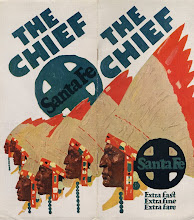Peddling past the Miami Beach Convention Center this morning en route to the Wolfsonian Museum, I noticed the banners by the entrance marketing the annual EXXXotica Expo, a three-day trade adult event billed as a "Celebration of Sexy." Hosting an adult trade show might seem out of place in other city convention centers, but it seemed perfectly in keeping with South Beach’s reputation for sun, skin, and hedonistic partying. Among the sponsors listed on the banner is WEAM, the World Erotic Art Museum, located on east side of Washington Avenue just a couple of blocks north of the Wolfsonian. The very different collections of the Wolfsonian and WEAM are not such as to invite confusion—although in the course of looking up Miami Beach museums on the internet, my brother-in-law from Colombia did assume that I worked for the latter museum. When he and his family visited last year, their guided tour through the Wolfsonian certainly altered their expectations of what they might see, but did not appear to be a let-down or disappointment.
Upon arriving at the museum this morning, I began to think about what objects in our collection might appeal to the typical EXXXotica expo attendee. The erotic tendency in art is, of course, as old as art itself if one considers the earliest cave drawings and sculpture. Even in a collection like the Wolfsonian which is weighted towards the propaganda and persuasive arts, there are objects and materials with an erotic edge. Certainly, artists like Eric Gill (British, 1882-1940) did not shy away from depicting the nude in his artwork, and certainly saw nothing incompatible in celebrating religiosity and the procreative urge of the world. http://www.librarydisplays.wolfsonian.org/Eric%20Gill/Eric%20Gill.htm
Our current library exhibit looks at the influence of body-builder and publisher Bernarr Macfadden and the Physical Culture Movement he championed. Macfadden used his publishing empire to attack Victorian prudery and to promote physically-healthier citizens and attitudes towards the human body. Ironically, while publications such as Sunshine and health magazine were originally attacked as pornographic, the nudist lifestyle they advocated in the 1930s was naturalistic rather than hedonistic, and marketed as family-friendly. http://www.librarydisplays.wolfsonian.org/Physical%20culture/PC.htm
Another area of the collection actually celebrates the erotic are some of the deluxe edition books produced in France in the interwar period. Often focusing on the decadence of the aristocratic class of the Ancien Régime and employing the pochoir (stencilwork) technique, these luxuriously illustrated books were marketed to a wealthy clientele with a penchant for erotica. The Wolfsonian has a number of such works in its collection, but my personal favorite is a parody of that erotic tradition. Elphie et son éléphant is a tongue-in-cheek satire of the popular Babar the Elephant character that appeared in children’s books promoting French nationalism and pride in her colonies. This playful parody for adults, however, chronicles the amorous adventures of an adulterous elephant. A few of these books and portfolio plates appeared in a past library display, Fashion and Passion: Deluxe Pochoir Editions.
http://www.librarydisplays.wolfsonian.org/Pochoir/Pochoir.htm
In the same period, European regimes also resorted to creating sexualized imagery of “native” women in much of the propaganda produced to drum up interest in their colonies. Posters, postcards, and other ephemera aimed at recruiting young men into colonial armies or promoting colonial tourism would invariably depict the women of those regions as enticingly exotic beauties.
Unquestionably, the most disturbing examples of sexual imagery in our collection are the propaganda materials created with the aim of sowing the seeds of hatred against real or perceived “enemies of the state.” During the First World War, the protagonists often resorted to employing subtle and obvious rape imagery to demonstrate the uttery depravity of the enemy. The “Huns” were frequently depicted as brute beasts intent on rape and their Turkish allies as degenerate Sultans smoking opium from hookahs and hanging out in harems.
In the wake of Adolf Hitler’s rise to power in Germany, the Nazis created many disturbing children’s books and booklets for adult depicting Jewish men leering at Aryan women and children with lecherous and perverse intent. During wartime, propaganda produced for the troops used “rape” imagery to inspire hatred for the enemy, while leaflets dropped behind enemy lines used sexualized imagery to sap the morale of lonely soldiers at the front or promote discord and distrust in the ranks of allied armies.











No comments:
Post a Comment